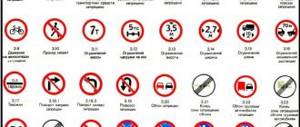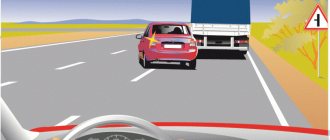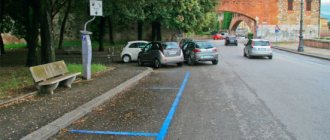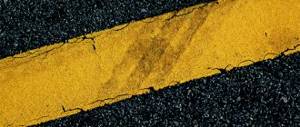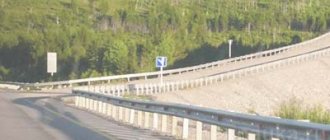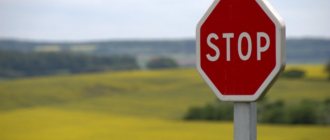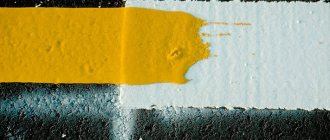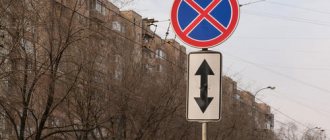What materials can be used to mark the road?
When selecting materials that will be used to mark the road, it is necessary to take into account a number of characteristics:
- Visibility in the dark;
- Durability;
- Price;
- Application speed;
- Roughness.
Among the variety of means for performing work, various dyes and thermoplastics are widely used. They allow you to mechanize the process and speed it up.
Considering the fact that markings are subject to the destructive effects of mechanisms and adverse natural phenomena, it is necessary to choose a durable material with reflective properties.
The most affordable option is to use various dyes, which include a pigment, a filler, a binder and a solvent.
Such markings must be updated every 2-4 months, focusing on the intensity of traffic flow.
The increase in costs for carrying out work to restore the coating leads to the growing popularity of thermoplastics, the service life of which is 2-3 years.
This material is a composition of a binder component made from natural or synthetic resins, pigment and filler.
How to apply road markings
The work is carried out in several stages:
- The work site is fenced.
- The surface is cleaned of dirt and dust using a watering machine or equipment with brushes and a blower. After wet cleaning, the surface is dried using gas-air burners or naturally.
- Traces of old paint are removed. This is necessary if its thickness exceeds 6 mm or it does not hold firmly, the contours or arrangement of elements change.
- The location of the applied elements is marked, control points and contours are marked.
- Marking equipment and materials are prepared for work - paint or plastic components are mixed, thermoplastic is heated, the material is filled into the tank of the painting machine, etc.
- Road applied either by machine or by hand .
- After the applied coating has completely dried, the fences are removed. Each of these stages is important to obtain a high-quality and durable result.
Our company provides services for applying road markings in accordance with the requirements of standards and technological rules. We use only high quality materials with maximum service life. We offer prices that do not exceed the city average, and we provide a guarantee for all types of work. Contact S-Project!
Also, by contacting us you can order:
- Installation of road signs
- TCT Projects and Traffic Tax Schemes
- Applying road markings
- Performing Topographic Survey
- Highway design
- Design of automated traffic control system or traffic light facilities
- Arrangement and design of parking lots, parking lots
- Development of Transport Service Schemes (STO/TS)
Optimal conditions for marking
To improve visibility and better visual perception, you can perform work using reflective materials:
- Coarse sand;
- Ceramic inclusions;
- Glass microbeads.
Road markings in the city are very diverse
Often the dividing strips are made slightly convex.
Important to remember! Before making new markings, it is necessary to thoroughly clean off paint residues, oil stains, and dirt. The old layer is removed by milling or burning with a gas jet.
Coating work is carried out at an air temperature of at least +5 C.
Types and scope of road markings
Depending on the surface on which the lines are drawn, the markings are:
- horizontal – on the surfaces of roads and platforms;
- vertical – on fences, bridges, overpasses;
Road markings are applied in all places where there is traffic:
- on any roads;
- parking lots, parking lots;
- territories of gas stations;
- loading and unloading areas;
- warehouses served by trucks;
- bike paths;
- airports;
- stations, platforms, etc.;
The location, color, size, shape of lines and symbols are determined by the current standards. It is also possible to apply road markings (non-standard) - numbering of parking spaces, brand logos in parking lots, advertising, etc.
What kind of paint is applied to roads?
For constant use on heavily trafficked highways, runways and airfields, you need paint that forms a wear-resistant coating.
The layer must be resistant to chemicals used in the fight against snow and ice, to bright light, be hard and impact-resistant. These requirements are met by the “Avtomagistralnaya” AK-511 road paint, which demonstrates high abrasion resistance due to the presence of acrylic copolymers and plasticizers in the composition.
The material forms a durable, bright coating of white or yellow colors. To improve visibility at night, reflective glass microbeads ranging in size from 70 to 300 microns are added to the freshly applied paint. The layer dries quickly - no longer than 30 minutes at an air temperature of +20 ° C. The paint is economical in consumption - 350–500 g/m2.
With the help of such glass chips, road markings become reflective
Recently the British expressed an interesting idea. They believe that if road markings are completely removed, traffic safety... will improve! In the absence of identification signs, drivers will drive slower (by about 13%) and will become more careful on the road. Perhaps someday this will happen. Today, in many countries, including Russia, they are in no hurry to abandon markings. This means that the priority is wear-resistant, durable materials, for example, convenient and practical paint.
Other organizations
Markup 1.2
Information about traffic rules markings. Marking 1.2 - where and when it is applied and in what cases it is valid.
Markup 1.26
Information about traffic rules markings. Marking 1.26 - where and when it is applied and in what cases it is valid.
Markup 2.7
Information about traffic rules markings. Marking 2.7 - where and when it is applied and in what cases it is valid.
Markup 2.6
Information about traffic rules markings. Marking 2.6 - where and when it is applied and in what cases it is valid.
Markup 2.5
Information about traffic rules markings. Marking 2.5 - where and when it is applied and in what cases it is valid.
Markup 2.4
Information about traffic rules markings. Marking 2.4 - where and when it is applied and in what cases it is valid.
Markup 2.3
Information about traffic rules markings. Marking 2.3 - where and when it is applied and in what cases it is valid.
Markup 2.2
Information about traffic rules markings. Marking 2.2 - where and when it is applied and in what cases it is valid.
Markup 2.1.3
Information about traffic rules markings. Marking 2.1.3 - where and when it is applied and in what cases it is valid.
Markup 2.1.2
Information about traffic rules markings. Marking 2.1.2 - where and when it is applied and in what cases it is valid.
Markup 2.1.1
Information about traffic rules markings. Marking 2.1.1 - where and when it is applied and in what cases it is valid.
Markup 1.25
Information about traffic rules markings. Marking 1.25 - where and when it is applied and in what cases it is valid.
Markup 1.24.4
Information about traffic rules markings. Marking 1.24.4 - where and when it is applied and in what cases it is valid.
Markup 1.24.3
Information about traffic rules markings. Marking 1.24.3 - where and when it is applied and in what cases it is valid.
Markup 1.24.2
Information about traffic rules markings. Marking 1.24.2 - where and when it is applied and in what cases it is valid.
Markup 1.24.1
Information about traffic rules markings. Marking 1.24.1 - where and when it is applied and in what cases it is valid.
Markup 1.23.3
Information about traffic rules markings. Marking 1.23.3 - where and when it is applied and in what cases it is valid.
Markup 1.23.2
Information about traffic rules markings. Marking 1.23.2 - where and when it is applied and in what cases it is valid.
Markup 1.23.1
Information about traffic rules markings. Marking 1.23.1 - where and when it is applied and in what cases it is valid.
Markup 1.22
Information about traffic rules markings. Marking 1.22 - where and when it is applied and in what cases it is valid.
Markup 1.21
Information about traffic rules markings. Marking 1.21 - where and when it is applied and in what cases it is valid.
Markup 1.20
Information about traffic rules markings. Marking 1.20 - where and when it is applied and in what cases it is valid.
Markup 1.19
Information about traffic rules markings. Marking 1.19 - where and when it is applied and in what cases it is valid.
Markup 1.18
Information about traffic rules markings. Marking 1.18 - where and when it is applied and in what cases it is valid.
Markup 1.17
Information about traffic rules markings. Marking 1.17 - where and when it is applied and in what cases it is valid.
Markup 1.16.3
Information about traffic rules markings. Marking 1.16.3 - where and when it is applied and in what cases it is valid.
Markup 1.16.2
Information about traffic rules markings. Marking 1.16.2 - where and when it is applied and in what cases it is valid.
Markup 1.16.1
Information about traffic rules markings. Marking 1.16.1 - where and when it is applied and in what cases it is valid.
Markup 1.15
Information about traffic rules markings. Marking 1.15 - where and when it is applied and in what cases it is valid.
Markup 1.14.2
Information about traffic rules markings. Marking 1.14.2 - where and when it is applied and in what cases it is valid.
Markup 1.14.1
Information about traffic rules markings. Marking 1.14.1 - where and when it is applied and in what cases it is valid.
Markup 1.13
Information about traffic rules markings. Marking 1.13 - where and when it is applied and in what cases it is valid.
Markup 1.12
Information about traffic rules markings. Marking 1.12 - where and when it is applied and in what cases it is valid.
Markup 1.11
Information about traffic rules markings. Marking 1.11 - where and when it is applied and in what cases it is valid.
Markup 1.10
Information about traffic rules markings. Marking 1.10 - where and when it is applied and in what cases it is valid.
Markup 1.9
Information about traffic rules markings. Marking 1.9 - where and when it is applied and in what cases it is valid.
Markup 1.8
Information about traffic rules markings. Marking 1.8 - where and when it is applied and in what cases it is valid.
Markup 1.7
Information about traffic rules markings. Marking 1.7 - where and when it is applied and in what cases it is valid.
Markup 1.6
Information about traffic rules markings. Marking 1.6 - where and when it is applied and in what cases it is valid.
Markup 1.5
Information about traffic rules markings. Marking 1.5 - where and when it is applied and in what cases it is valid.
Markup 1.4
Information about traffic rules markings. Marking 1.4 - where and when it is applied and in what cases it is valid.
Markup 1.3
Information about traffic rules markings. Marking 1.3 - where and when it is applied and in what cases it is valid.
Markup 1.2.2
Information about traffic rules markings. Marking 1.2.2 - where and when it is applied and in what cases it is valid.
Markup 1.2.1
Information about traffic rules markings. Marking 1.2.1 - where and when it is applied and in what cases it is valid.
How to apply road markings
The surface is cleaned using special equipment or manually. If necessary, perform routine coating repairs, fill cracks, and inspect hatches. If the road is wet, it is dried. If plastic or polymer tapes are chosen, a primer is applied to cement concrete and old asphalt pavements to increase adhesion. Preliminary marking is being carried out.
Depending on the material, certain technology/equipment is used. The easiest way to work is with paint. One-component compositions are applied by pneumatic or hydraulic spraying. Multi-component - mix first. Stencils are used in the work. If there are none, the lines and symbols to be applied are limited with adhesive tape.
The work is carried out on a dry sunny day at an air temperature of at least +5 °C. In rainy or frosty weather, specialized equipment is needed to warm up and dry the road, as well as special marking material. The applied layer must dry within an hour before vehicles can drive on the road.
Using the “cold” method, paints, enamels, and cold plastics are applied to the road. “Hot” (at a melt temperature of 180–220 °C) – thermoplastics, spray plastics and thermoplastic tapes. You can work with them in the air temperature range of +5…+35 °C. The most convenient to apply and safe are paints and enamels that can last from one season to one year.
The best time to apply road markings is spring or autumn
Video
Road markings are applied differently in different countries. For example, in the USA, special equipment is used for this, and work is often performed in the dark:
